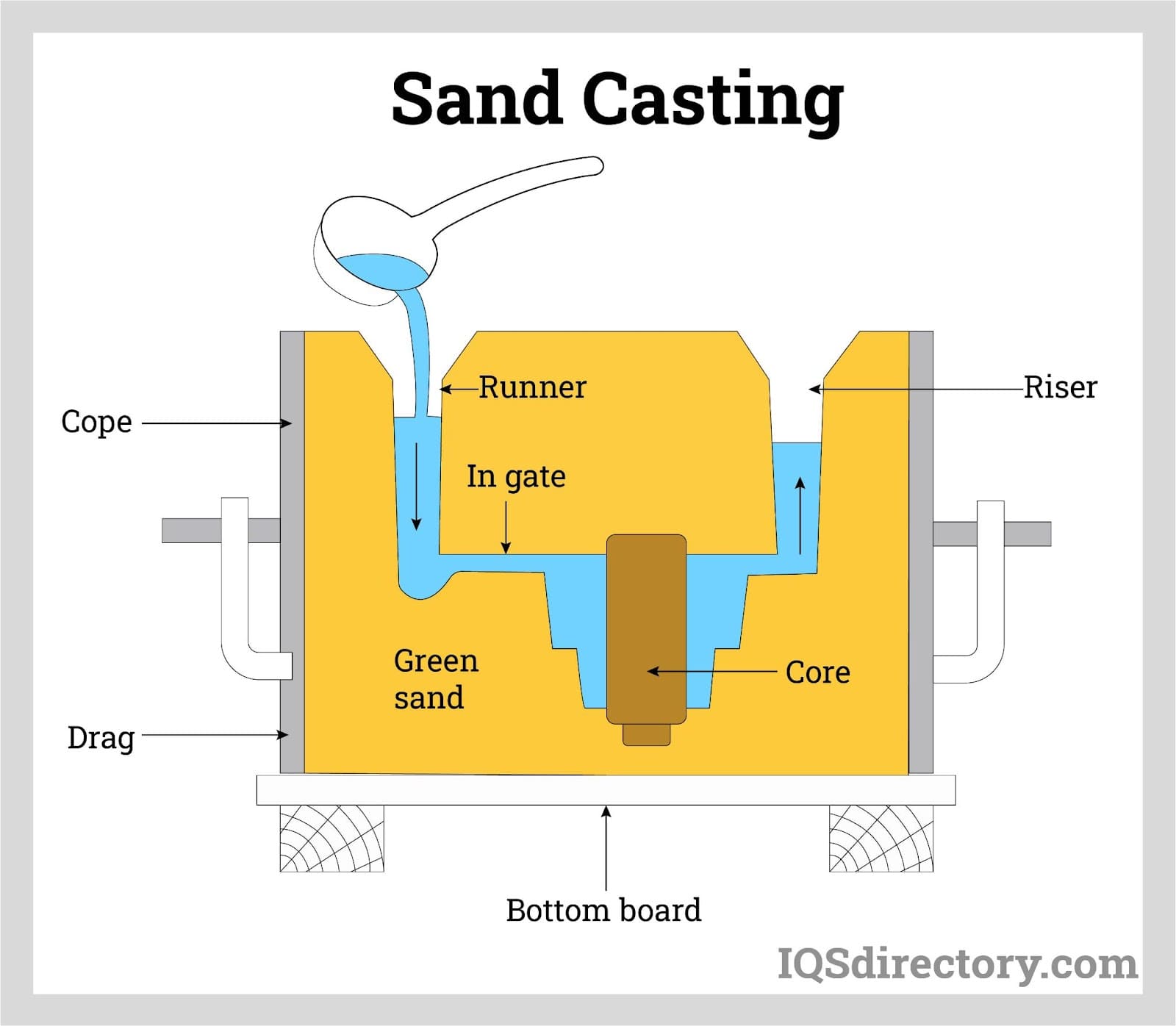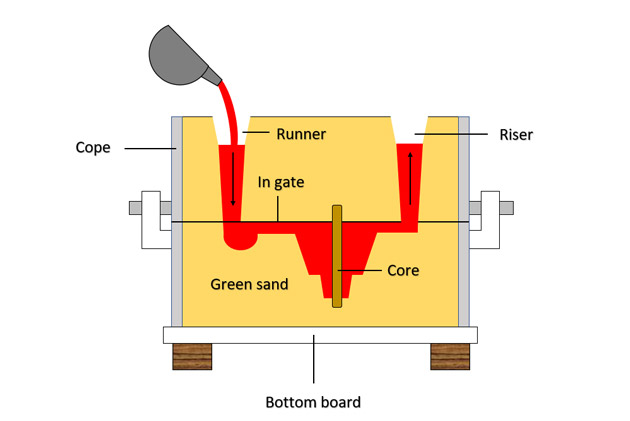Aluminum Foundry Wisconsin fuels growth in casting technologies
Wiki Article
Exactly How Aluminum Foundry Adds To Developments in Aerospace Design
Aluminum foundries are indispensable to advancements in aerospace design. They create lightweight, high-strength parts that are essential for contemporary aircraft. Through advanced casting strategies, these factories develop complicated geometries that boost structural honesty. Additionally, the development of superior Aluminum alloys sustains the industry's focus on fuel efficiency and sustainability. Nevertheless, difficulties continue to be in the manufacturing procedure. Understanding these variables reveals the profound influence of Aluminum on aeronautics's future.The Significance of Lightweight Materials in Aerospace Design
As the aerospace market remains to progress, the relevance of light-weight products ends up being significantly noticeable. The need for performance and sustainability drives designers to focus on making use of products that minimize overall weight without jeopardizing structural integrity. Light-weight products, specifically Aluminum, play a necessary duty in improving fuel efficiency, boosting haul capability, and boosting the total efficiency of airplane.In addition, the assimilation of these materials enables ingenious styles, allowing manufacturers to create more aerodynamic forms that can endure severe problems. The decrease in weight not just reduces operational prices yet additionally contributes to a reduced ecological footprint, lining up with international efforts towards sustainability in aeronautics.
Advanced Casting Techniques in Aluminum Foundries
Advanced casting techniques in Aluminum shops play an important function in aerospace design by allowing the manufacturing of lightweight and precise elements. Developments in mold and mildew layout and precision casting processes are important in accomplishing ideal efficiency and architectural integrity. Additionally, the development of light-weight alloys enhances the general efficiency and performance of aerospace applications.Ingenious Mold And Mildew Layout
Cutting-edge mold layout plays a crucial role in the effectiveness and effectiveness of Aluminum shops, especially within the aerospace market. By leveraging sophisticated materials and methods, modern-day mold and mildews can be crafted to stand up to high temperature levels and stress, making certain peak performance during the spreading process. These layouts usually integrate intricate geometries that permit the production of light-weight yet structurally sound components, essential for aerospace applications. In addition, making use of computer-aided layout (CAD) software application promotes precise modeling, making it possible for foundries to fine-tune and imitate mold layouts before physical manufacturing starts. This not only enhances the high quality of actors components but likewise reduces waste and preparation, causing considerable cost financial savings. In general, ingenious mold layout is a keystone of progression in Aluminum Foundry technology for aerospace design.Precision Casting Procedures
The effectiveness of cutting-edge mold layouts flawlessly incorporates with precision casting processes, which are crucial for generating premium Aluminum elements in aerospace design. These procedures, including sand casting, die casting, and investment casting, ensure the creation of complex geometries with limited tolerances. Advanced techniques like vacuum cleaner casting and pressure pass away casting boost the integrity and surface coating of the end products. Precision spreading reduces product waste while optimizing the mechanical residential or commercial properties of Aluminum, vital for aerospace applications. In addition, using real-time monitoring and progressed simulation devices during the casting process permits instant modifications, leading to enhanced top quality control. Jointly, these accuracy casting processes placement Aluminum foundries at the leading edge of aerospace technology, supporting the sector's need for dependability and efficiency.Light-weight Alloy Advancement
As aerospace designers look for to boost fuel performance and efficiency, light-weight alloy advancement becomes an important focus in Aluminum factories. These shops employ innovative casting methods to develop alloys that provide remarkable strength-to-weight proportions. Advancements in alloy structure, including the incorporation of aspects like lithium and magnesium, allow the production of products that endure extreme problems while decreasing general airplane weight. Strategies such as die spreading and investment casting help with the precision production of intricate forms, which are vital for aerospace applications. In addition, ongoing study intends to maximize these alloys for enhanced mechanical properties and increased resilience. By prioritizing lightweight alloy growth, Aluminum factories greatly contribute to the advancement of aerospace design, leading the way for a lot more lasting and effective airplane styles.
Enhancing Architectural Honesty Through Aluminum Elements
Aluminum parts offer substantial benefits in improving structural stability within aerospace design. Their light-weight nature contributes to overall efficiency while keeping strength, which is necessary for airplane efficiency. Additionally, the anxiety resistance residential properties of Aluminum help guarantee the durability and reliability of aerospace frameworks under different operational conditions.
Lightweight Product Perks
While traditional materials usually endanger weight for stamina, utilizing Aluminum elements in aerospace engineering uses significant benefits in structural stability. Aluminum's lightweight nature adds to general design efficiency, allowing for more structured aircraft that consume less fuel, thereby enhancing sustainability. The material's exceptional strength-to-weight proportion warranties that elements keep longevity without adding unneeded mass. This quality cultivates enhanced efficiency and agility in trip, as well as maximized payload capabilities. Additionally, Aluminum's resistance to rust lengthens the lifespan of aerospace structures, lowering maintenance costs and boosting security. As manufacturers progressively adopt Aluminum alloys, the aerospace market experiences a transformative shift towards a lot more effective and effective engineering solutions that prioritize both efficiency and environmental duty.Anxiety Resistance Features
Different products have one-of-a-kind residential properties, Aluminum's exceptional tension resistance stands out as a vital variable in boosting the architectural integrity of aerospace components. This resistance plays an essential duty in making sure that aircraft can endure numerous operational tensions, consisting of fatigue, impact, and environmental conditions. Aluminum alloys, especially crafted for aerospace applications, display high tensile strength while maintaining lightweight qualities, enabling engineers to create extra efficient structures - Aluminum Foundry. In addition, the capability of Aluminum to withstand cyclic loading without substantial contortion contributes to the long life and reliability of aerospace parts. As developments continue in Aluminum Foundry strategies, the growth of stress-resistant Aluminum parts promises further improvements in efficiency, safety and security, and efficiency across the aerospace industry, solidifying Aluminum's duty as a recommended material in contemporary engineeringFuel Efficiency Improvements Driven by Aluminum Innovations
As the aerospace market seeks to boost gas performance, ingenious uses of Aluminum have actually become a crucial service. Aluminum's light-weight nature significantly decreases airplane weight, enabling lower fuel usage throughout flight. This decrease in weight is crucial, as also little declines can cause significant improvements in overall fuel economy.Advanced Aluminum alloys, made for enhanced toughness and toughness, allow manufacturers to create parts that keep architectural honesty while minimizing mass - Aluminum Foundry. Furthermore, the assimilation of Aluminum about his in airframes and engine elements helps with improved aerodynamics, adding to lowered drag and enhanced performance
The adoption of Aluminum in aerospace not just meets the demand for fuel-efficient layout however additionally aligns with governing pressures for reduced exhausts. As these technologies remain to evolve, they play a considerable function in setting new criteria for gas efficiency, making sure that the aerospace market can fulfill growing economic and ecological obstacles.

The Duty of Aluminum in Sustainable Aeronautics Practices
The boosting focus on sustainable air travel techniques has positioned Aluminum as an essential product in the quest for greener aircraft design. Known for its click to find out more lightweight homes, Aluminum significantly reduces aircraft weight, resulting in lower fuel consumption and emissions. Its recyclability further enhances its sustainability profile, as Aluminum can be recycled forever without loss of top quality. This characteristic supports a round economic situation within the aviation market, lessening waste and source exhaustion.Advancements in Aluminum alloys have actually enhanced their stamina and deterioration resistance, allowing for longer solution life and decreased upkeep requirements. These technologies assist in the advancement of a lot more efficient airplane frameworks, adding to general sustainability initiatives. Furthermore, Aluminum's thermal conductivity plays a critical role in energy-efficient designs, improving systems such as warm exchangers. Jointly, these features underscore Aluminum's crucial function ahead of time sustainable aeronautics, straightening with international initiatives intended at minimizing the environmental impact of flight.
Obstacles Encountered by Aluminum Foundries in Aerospace Manufacturing
While Aluminum foundries play a necessary role in aerospace production, they encounter substantial obstacles that can influence manufacturing efficiency and top quality. One major obstacle is the stringent top quality control standards required in the aerospace sector. Any kind of flaw can jeopardize safety and security and performance, necessitating rigorous examination processes that expand production timelines. Additionally, foundries commonly emulate changing raw material costs, which can affect rates and productivity. The intricacy of Aluminum alloys utilized in aerospace applications further complicates the production procedure, as accurate formulations are crucial for attaining preferred mechanical properties. Skilled labor scarcities hinder the ability to preserve top quality manufacturing levels. Finally, ecological policies enforce limitations on emissions and waste monitoring, requiring factories to invest in lasting methods, which can be cost-prohibitive. These aspects jointly produce a landscape where Aluminum factories have to continuously adjust to fulfill the progressing needs of aerospace manufacturing while making certain safety and compliance.Future Fads in Aluminum Applications for Aerospace Design
you can try here With developments in modern technology and enhancing needs for effectiveness, the future of Aluminum applications in aerospace design is poised for considerable transformation. The combination of innovative Aluminum alloys and composites is anticipated to boost strength-to-weight proportions, leading to more fuel-efficient airplane designs. On top of that, improvements in additive production strategies will allow for the production of complex Aluminum structures that were previously impossible, optimizing performance and reducing waste.
Lasting practices will certainly play a vital duty, with a growing focus on reusing Aluminum to lessen ecological effect. The aerospace field is most likely to welcome smarter producing processes, such as automation and fabricated intelligence, making certain better and precision in Aluminum elements. Moreover, partnerships between Aluminum shops and aerospace business will promote research study and development, paving the way for new applications that meet the strict requirements of contemporary aerospace design - Aluminum Foundry. Overall, the future looks guaranteeing for Aluminum's duty in shaping the skies
Regularly Asked Concerns
What Are the Environmental Impacts of Aluminum Manufacturing in Aerospace?
The ecological impacts of Aluminum manufacturing in aerospace include significant energy usage, greenhouse gas emissions, and environment disturbance. Additionally, mining procedures can lead to soil deterioration and water contamination, increasing issues concerning sustainability and environmental equilibrium.Exactly How Does Aluminum Contrast to Various Other Products in Aerospace Applications?
Aluminum provides a special combination of lightweight homes, rust resistance, and cost-effectiveness compared to other products. Its high strength-to-weight proportion makes it particularly beneficial for aerospace applications, enhancing fuel efficiency and general performance in airplane design.What Qualifications Do Aluminum Foundry Workers Requirement for Aerospace Projects?
Aluminum Foundry workers require customized training in metallurgy and spreading techniques, along with expertise of aerospace market requirements. Accreditations in quality control and safety and security procedures are additionally important to guarantee conformity with stringent aerospace job needs.Exist Any Kind Of Security Worry About Using Aluminum in Aerospace Engineering?
Safety and security worries concerning Aluminum in aerospace design include sensitivity to deterioration, tension, and tiredness fractures. Correct treatment and alloy choice are necessary to mitigate these dangers, ensuring structural honesty and overall safety and security in aerospace applications.Exactly How Does Aluminum Recycling Advantage the Aerospace Industry?
Aluminum reusing substantially benefits the aerospace industry by reducing material expenses, lessening ecological effect, and saving energy. This sustainable method improves the market's effectiveness while advertising using lightweight, high-performance components in aircraft manufacturing.Advanced casting techniques in Aluminum foundries play an important role in aerospace design by making it possible for the production of light-weight and accurate parts. Cutting-edge mold and mildew layout plays a vital role in the performance and effectiveness of Aluminum shops, particularly within the aerospace field. As aerospace engineers seek to boost gas performance and efficiency, light-weight alloy advancement comes to be a crucial emphasis in Aluminum foundries. Aluminum alloys, especially engineered for aerospace applications, display high tensile toughness while preserving lightweight attributes, making it possible for engineers to create much more effective frameworks. Partnerships between Aluminum factories and aerospace companies will foster research and growth, paving the way for brand-new applications that meet the rigorous needs of modern aerospace engineering.
Report this wiki page